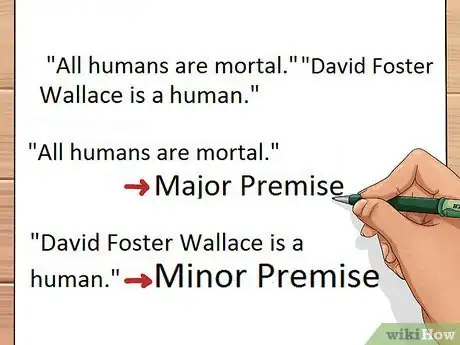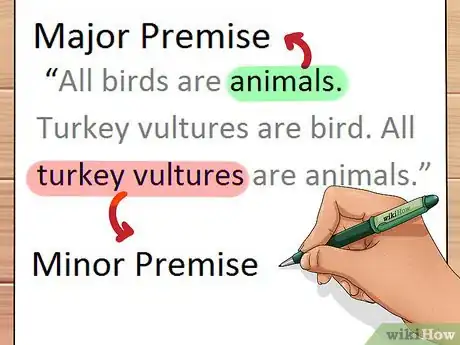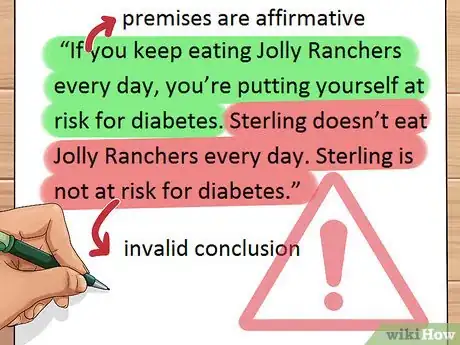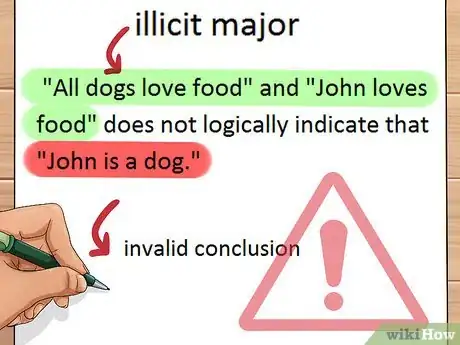This article was co-authored by wikiHow Staff. Our trained team of editors and researchers validate articles for accuracy and comprehensiveness. wikiHow's Content Management Team carefully monitors the work from our editorial staff to ensure that each article is backed by trusted research and meets our high quality standards.
wikiHow marks an article as reader-approved once it receives enough positive feedback. In this case, several readers have written to tell us that this article was helpful to them, earning it our reader-approved status.
This article has been viewed 556,724 times.
Learn more...
A syllogism is a logical argument composed of three parts: the major premise, the minor premise, and the conclusion inferred from the premises. Syllogisms make statements that are generally true in a particular situation. In doing so, syllogisms often provide for both compelling literature and rhetoric, as well as irrefutable argumentation.[1] Syllogisms are an integral component of the formal study of logic, and are commonly featured in aptitude tests meant to assess logical reasoning abilities.
Steps
Familiarizing Yourself with the Vocabulary of Syllogisms
-
1Recognize how a syllogism makes an argument. To understand syllogisms, you need to familiarize yourself with several terms often used when discussing formal logic. At the most basic level, a syllogism is the simplest sequence of a combination of logical premises that lead to a conclusion. A premise is a proposition that is used as evidence in an argument. A conclusion is asserted by the logical result of an argument based on the relationship of the stated premises.[2]
- Consider the conclusion of a syllogism to be the “thesis” of an argument. In other words, the conclusion is the point proven by the premises.
-
2Determine the three parts of a syllogism. Recall that a syllogism includes a major premise, a minor premise, and a conclusion. Jumping into an example: “All humans are mortal” might function as a major premise, and would stand as a generally accepted fact. “David Foster Wallace is a human” might follow as a minor premise.[3]
- Notice that the minor premise is more specific, and immediately relates to the major premise.
- If each of the prior statements are considered valid, the logical conclusion would be “David Foster Wallace is mortal.”
Advertisement -
3Determine the minor and major terms. Both the minor and major premises of a syllogism must have one term in common with the conclusion. The term that is in both the major premise and the conclusion is the major term, which forms the predicate of the conclusion – in other words, it states something about the subject of the conclusion. The term shared by the minor premise and the conclusion is the minor term, which will be the subject of the conclusion.[4]
- Consider the example: “All birds are animals. Turkey vultures are bird. All turkey vultures are animals.”
- Here, “animal” is the major term, as it is in both the major premise and is the predicate of the conclusion.
- “Turkey vulture” is the minor term, as it is in the minor premise and is the subject of the conclusion.
- Notice that there is also a categorical term shared by the two premises, in this case “bird.” This is called the middle term, and is of immense importance in determining the figure of the syllogism, which is addressed in a later step.
-
4Look for categorical terms. If you're preparing for a logical reasoning test, or simply want to better understand syllogisms in general, note that most syllogism you will encounter will be categorical. This means that they will rely on reasoning akin to: “If ____ are/are not [members of a category], then ____ are/are not [also members of that category/a different category]”
- Another way to think of the logical sequence employed by categorical syllogisms is that they all employ the logical sequence of “Some/all/no _____ is/isn't ______.”
-
5Understand the distribution of terms in a syllogism. There are four different types of propositions that can be made by each of the three parts of a syllogism. Think of how they differ in terms of how they each distribute – or don't distribute – any categorical term. Consider a categorical terms to be “distributed” only if all individual members of that category are accounted for in the term. For example, in the premise "all men are mortal", the term "men" is distributed, as every member belonging to that category is accounted for – in this case, as mortal. Note how each of the four different types of propositions distributes (or does not distribute) the terms:
- In "All X are Y" propositions, the subject (X) is distributed.
- In "No X are Y" propositions, both the subject (X) and the predicate (Y) are distributed.
- In "Some X are Y" propositions, neither the subject nor the predicate are distributed.
- In "Some X are not Y" propositions, the predicate (Y) is distributed.
-
6Identify an enthymeme. Enthymemes, aside from having another really hard to pronounce name, are simply compressed syllogisms. Another way to think of an enthymeme is as a one-sentence syllogism, which may help you recognize both how and why syllogisms are a convenient reasoning device.[5]
- In specific terms, enthymemes disregard the major premise and combine the minor premise with the conclusion.
- For instance, consider the syllogism: “All dogs are canine. Lola is a dog. Lola is a canine.” The enthymeme of this same logical sequence would be: “Lola is a canine because she's a dog.”
- Another example of an enthymeme is “David Foster Wallace is mortal because he is human.”
Identifying an Invalid Syllogism
-
1Distinguish between validity and soundness. A logically valid syllogism is one in which the premises entail the conclusion, in that it is impossible for the premises to be true and the conclusion to be false. However, it is possible for a valid syllogism to be factually untrue if its premises are false. This is called an unsound syllogism. Sound syllogisms are valid syllogisms with true premises. A sound syllogism is truth-preserving, where true propositions entail a true conclusion.[6]
- For instance, consider the syllogism: “All dogs can fly. Fido is a dog. Fido can fly.” This syllogism is logically valid, but since the major premise is untrue, the conclusion is clearly inaccurate and the syllogism is unsound.
- The structure of the argument made by a syllogism – the reasoning of the argument itself – is what you're assessing when assessing a syllogism for logical validity. When assessing soundness, you're assessing both its validity and the factual accuracy of its premises.
-
2Look for linguistic giveaways that indicate invalidity. Observe the affirmative or negative nature of the premises and conclusion when looking to determine validity. Note that if either of the premises is negative, the conclusion must also be negative. If both premises are affirmative, the conclusion must also be affirmative. If any of these rules are not followed, you already know the syllogism is invalid.
- Further, at least one of a syllogism's two premises must be affirmative, as no valid conclusion can follow from two negative premises. For example, "No pencils are cats, some cats are not pets, therefore some pets are not pencils" has true premises and a true conclusion, but is invalid because of its two negative premises. If transposed, it would reach the nonsensical conclusion that some pets are pencils.
- Further, at least one premise of a valid syllogism must contain a universal form. If both premises are particular, then no valid conclusion can follow. For example,“some cats are black" and "some black things are tables" are both particular propositions, so it cannot follow that "some cats are tables".
- You'll often simply know that a syllogism that breaks one of these rules is invalid without thinking about it, as it will likely sound illogical.
-
3Be skeptical of conditional syllogisms. Conditional syllogisms are hypothetical, and their conclusions are not always valid, as they depend on the condition that an unproven premise is true. Conditional syllogisms will include reasoning along the lines of “If_____, then_____.” These syllogisms are not valid when there are additional factors that may contribute to a conclusion.
- For instance: “If you keep eating Jolly Ranchers every day, you're putting yourself at risk for diabetes. Sterling doesn't eat Jolly Ranchers every day. Sterling is not at risk for diabetes.”
- This syllogism is not valid for several reasons. Among them, Sterling may eat copious amounts of Jolly Ranchers several days a week – just not every day – which would still place him at risk for diabetes. Or, Sterling may eat cake every day, which would definitely place him at risk for diabetes.
-
4Watch out for syllogistic fallacies. Syllogisms can allow for incorrect conclusions to be implied by a false argument. Consider the example: “Jesus walked on water. The green basilisk lizard walks on water. The green basilisk lizard is Jesus.” This conclusion is not necessarily true, as the middle term – in this case, “[the ability to walk on water]” – is not distributed in the conclusion.[7]
- As another example: "All dogs love food" and "John loves food" does not logically indicate that "John is a dog." These are called fallacies of the undistributed middle, wherein a term that links the two phrases is never fully distributed.
- Beware of the fallacy of the illicit major, too. For instance, consider: "All cats are animals. No dogs are cats. No dogs are animals." This is invalid because the major term "animals" is undistributed in the major premise – not all animals are cats, but the conclusion relies on this insinuation.
- The same may be said of an illicit minor. For instance: "All cats are mammals. All cats are animals. All animals are mammals." This is invalid because, again, not all animals are cats, and the conclusion relies on this invalid insinuation.
Determining the Form and Figure of a Categorical Syllogism
-
1Recognize types of propositions. If each of a syllogism's premises are accepted as valid, the conclusion may also be valid. Logical validity, however, also depends on the form and figure of the syllogism, which both depend on the propositions of the syllogism. In categorical syllogisms, four different types of propositions are used to make up the premises and the conclusion.
- “A” propositions propose a universal affirmative, such as “all [categorical or specific term] are [a different categorical or specific term].” For example “All cats are felines.”
- “E” propositions propose exactly the opposite: a universal negative. For instance, “no [categorical of specific term] are [a different categorical or specific term].” More demonstratively, “No dogs are felines.”
- “I” propositions include a particular affirmative qualification in reference to one of the terms in the premise. For instance, “Some cats are black.”
- “O” propositions are the opposite, including a particular negative qualification. For instance, “Some cats are not black.”
-
2Identify the mood of a syllogism based on its propositions. By identifying which of the four types of propositions are used, we can reduce a syllogism to three letters to help determine whether it's a valid form for the figure of that particular syllogism. Different figures of syllogisms will be described in a following step. For now, simply understand that you can label each part of syllogism – including each premise and the conclusion – according to which type of proposition they make to identify the syllogism's mood.
- For instance, consider a categorical syllogism with the mood of AAA: “All X are Y. All Y are Z. So, all X are Z.
- A mood refers only to the types of propositions employed in a syllogism of standard order – major premise, minor premise, conclusion – and may be the same for two different forms based on the figure of the syllogisms in question.
-
3Determine the “figure” of the syllogism. A syllogism's figure is determined by whether the middle term serves as subject or predicate in the premises. Recall that a subject is what the sentence is about, and the predicate is a word that applies to the subject of the sentence.[8]
- In a first figure syllogism, the middle term serves as subject in the major premise and predicate in the minor premise: "All birds are animals. All parrots are birds. All parrots are animals".
- In a second figure syllogism, the middle term serves as predicate in the major premise and predicate in the minor premise. For instance: "No foxes are birds. All parrots are birds. No parrots are foxes."
- In a third figure syllogism, the middle term serves as subject in the major premise and subject in the minor premise. For instance: "All birds are animals. All birds are mortals. Some mortals are animals."
- In a fourth figure syllogism, the middle term serves as predicate in the major premise and subject in the minor premise. For instance: "No birds are cows. All cows are animals. Some animals are not birds."
-
4Recognize the valid forms of syllogisms. Although there are 256 mathematically possible forms of syllogisms – since there are 4 possible variations (A/E/I/O) for each part of a syllogism, and 4 different figures of syllogisms – only 19 forms are logically valid.[9]
- For first figure syllogisms, the valid forms are AAA, EAE, AII, and EIO.
- For second figure syllogisms, the valid forms are EAE, AEE, EIO, and AOO.
- For third figure syllogisms, the valid forms are AAI, IAI, AII, EAO, OAO, and EIO.
- For fourth figure syllogisms, the valid forms are AAI, AEE, IAI, EAO, and EIO.
Community Q&A
-
QuestionCan I define syllogism in simpler terms?
 Community AnswerIf A=B and B=C then A=C. This works fairly well though sometimes the order is mixed up. To use one of their examples "All birds are animals. Turkey vultures are birds. Turkey vultures are animals." birds=A animals=B turkey vultures=C. So if A=B and C=A then C=B
Community AnswerIf A=B and B=C then A=C. This works fairly well though sometimes the order is mixed up. To use one of their examples "All birds are animals. Turkey vultures are birds. Turkey vultures are animals." birds=A animals=B turkey vultures=C. So if A=B and C=A then C=B -
QuestionCan you expand the article to explain the meanings of A, E, I and O?
 Community Answer"A" means universal affirmative, "E" means universal negative, "I" means particular affirmative and "O" means particular negative.
Community Answer"A" means universal affirmative, "E" means universal negative, "I" means particular affirmative and "O" means particular negative. -
QuestionIs "Humans are mammals. Some humans are engineers." a syllogism?
 Community AnswerNope. A syllogism has three parts, including a conclusion. These two statements might be considered two premises. If a conclusion was added, such as "Some mammals are engineers.", the three statement would together make a syllogism.
Community AnswerNope. A syllogism has three parts, including a conclusion. These two statements might be considered two premises. If a conclusion was added, such as "Some mammals are engineers.", the three statement would together make a syllogism.
References
- ↑ http://literarydevices.net/syllogism/
- ↑ https://owl.english.purdue.edu/owl/owlprint/659/
- ↑ http://literarydevices.net/syllogism/
- ↑ http://literarydevices.net/syllogism/
- ↑ http://literarydevices.net/syllogism/
- ↑ https://web.cn.edu/kwheeler/documents/Syllogisms.pdf
- ↑ http://literarydevices.net/syllogism/
- ↑ http://philebus.tamu.edu/phil240/LectureNotes/6.1.pdf
- ↑ http://philebus.tamu.edu/phil240/LectureNotes/6.1.pdf
About This Article
To understand syllogisms, practice recognizing the major premise. An example of a major premise is “All humans are mortal.” Next, recognize the second part of the syllogism, the minor premise. An example of a minor premise is “David Foster Wallace is a human.” Finally, apply the premises to each other: if David is a human, then according to the major premise, David is also a mortal. You can then determine that the conclusion of the syllogism is “David Foster Wallace is mortal.” For more information on how to determine the validity of a syllogism, continue reading!





















-Step-10-Version-3.webp)






















































